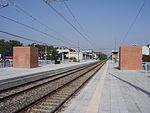Barona

Barona is a border district ("quartiere") of the city of Milan, Italy. It is part of the Zone 6 administrative division, and it is located south of the city centre. Its population can be roughly estimated to 85,000 (official data are not available as districts are not formal divisions). It borders on the comunes of Buccinasco, Assago, and Corsico and the districts of Lorenteggio and Torretta. Its boundaries are marked by the Parco Agricolo Sud Milano nature reserve to the south, by the Naviglio Grande and Naviglio Pavese canals to the east and to the west, and by the Circonvallazione ring road to the north (more specifically, by the Viale Cassala and Viale Tibaldi avenues). Barona is a mainly residential district, and one of those having a higher proportion of green areas still devoted to agriculture. The most typical features of the agricultural areas in Barona, as well as in the neighbouring semi-rural districts and communes, are the water-meadows and paddy fields. It has two main urban sub-districts, Sant'Ambrogio I and Sant'Ambrogio II. Sant'Ambrogio I has landmark, curvy buildings, constructed in the 1960s, housing about 5,000 people. Sant'Ambrogio II developed between the 1960s and 1970s and has prefabricated apartment buildings of simpler design. The district includes two well known community centres, Barrio's and Villaggio Barona.
Excerpt from the Wikipedia article Barona (License: CC BY-SA 3.0, Authors, Images).Barona
Via Biella, Milan Municipio 6
Geographical coordinates (GPS) Address Nearby Places Show on map
Geographical coordinates (GPS)
| Latitude | Longitude |
|---|---|
| N 45.44 ° | E 9.1558333333333 ° |
Address
Via Biella - Via Binda
Via Biella
20142 Milan, Municipio 6
Lombardy, Italy
Open on Google Maps









